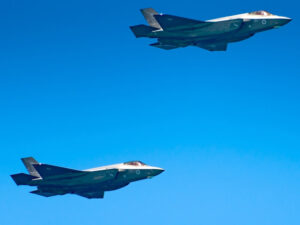As Ukraine’s valiant fight against Vladimir Putin’s full-scale invasion enters its third year, the U.S. Army’s newly released fiscal 2025 budget incorporates the top lessons from combat in Ukraine and sends a powerful message as a deterrent against possible conflict with China.
Here are four key insights about the budget starting with munitions, air defense and armored vehicles and culminating with the rising dominance of deep sensing, which is the collection of data to support targeting, situational awareness and decision-making.
Surging munitions, replenishing stockpiles
The first lesson out of Ukraine was to surge munitions for the U.S. arsenal and to provide a hedge against any possible move by China against Taiwan. The Army moved fast to stimulate new U.S. production, using supplemental funding for a jump start. In fiscal 2025, the Army budget deepens this commitment. Manufacturing capacity for 155 mm caliber shells is growing from under 20,000 rounds per month before the war to 72,000 rounds per month at the end of FY25 and upward to 102,000 rounds per month in 2026.
The Army is also boosting missile procurement from $5 billion in 2024 to a hefty $6.2 billion in 2025. This budget funds over $1 billion dollars of procurement for Guided Multiple Launch Rocket System (GMLRS) alone. No surprise, given that GMLRS is a go-to munition enabling Ukraine to carry out deep strikes on Russian military targets in the field. The increase beefs up “critical shooters,” according to Army Maj. Gen. Mark Bennett, director for Army budget, who spoke at an AUSA forum on March 18.
Another immediate lesson was to prioritize air defense. Russia’s missile barrages on Kyiv and other targets haven’t stopped. In fact, Russia launched 150 missiles against Ukraine overnight on Mar. 22, the single biggest attack of the war. Ukraine intercepted over 90 of the missiles but suffered significant damage to its electricity grid.
As the Army recognizes, sustained operations in any China scenario will tax air defenses at an order of magnitude beyond the activity in Ukraine. Hence, the Army funds a multi-year buy for Patriot PAC 3.
The fiscal 2025 budget is also serious about better cruise missile defense. Russia’s attacks in Ukraine have been bad enough, and China’s possible attacks against Taiwan could be much worse. The Indirect Fire Protection Capability (IFPC) launches maneuvering AIM-9X missiles at enemy cruise missiles, and with fiscal 2025 money the Army is funding four more IFPC battalions and working on a second interceptor.
Ukraine underscores U.S. need for armor
The Ukraine war continues to demonstrate that it takes armored vehicles to counter what one analyst called “chronic Russian aggression.” That’s why Poland has 250 new M1 Abrams and 116 retired M1s on order. The Army’s 2025 budget responds with investment in the M1E3 Abrams modernization. “The war in Ukraine has highlighted a critical need for integrated protections for soldiers, built from within instead of adding on,” U.S. Army Maj. Gen. Glenn Dean, program executive officer for ground combat systems, said at the M1E3 Abrams announcement last year.
The war in Ukraine also adds to the need for lighter armored vehicles. The 2025 budget procures 33 new M10 Booker armored vehicles plus more across a five-year plan. The XM30 Mechanized Infantry Combat Vehicle prototypes are also funded as competition progresses.
A growing requirement for “deep sensing”
According to the Wall Street Journal, a Ukrainian assault team last August guided an unmanned, armored vehicle to sneak up on a group of Russian soldiers over two miles away and fire 300 bullets at them. While the Army has led the development of manned-unmanned teaming for years, combat confirms the requirement.
As the vignette shows, deep sensing is a priority straight out of the Ukraine war. Army Chief of Staff Gen. Randy George said on Mar. 7 that the Army Futures Command will next create a cross-functional team focused on deep sensing capabilities.
Of course, deep sensing (under different nomenclature) is not new. The Army Air Forces employed it against German units behind the Normandy beachheads. Cold War doctrine in Europe relied on sensing and precision strike of second echelon areas, and so did the roll up of Iraqi forces in the four-day ground war of Operation Desert Storm in 1991.
However, the lessons from Ukraine are stark, and have played no small part in the decision to set up a dedicated deep sensing team. Ukraine has cobbled together a mesh of unmanned systems that reach from three miles to 45 miles beyond the front lines. This type of deep sensing is at the core of Ukraine’s ability to look and strike deep against Russian troops and logistics. Deep sensing enabled Ukraine’s three major campaign success in 2022: stopping Russia in the Donbass, retaking Kharkiv, and pressuring Russia’s Dnieper River bridgehead at Kherson, leading to a Russian withdrawal, according to a 2023 Army War College study.
For the U.S. Army, of course, deep sensing will roam farther, especially in the Pacific region. Once it is launched, the Army’s new deep sensing cross-functional team working at Army Futures Command can seek out platforms ranging from high-altitude balloons to solar-powered aircraft to host sensor payloads. It is no coincidence that the Army’s Future Tactical Unmanned Aircraft System gained funding from reinvestment after the February cancellation of Future Attack and Reconnaissance Aircraft (FARA). Deep sensing is a job for unmanned systems.
In any possible showdown with China, the Army in the Pacific will operate with naval forces, airpower, space operations and cyberattacks. However, munitions, air defense, the right mix of armored vehicles, and most of all, dominance in deep sensing will make the difference for victory, whether that comes via deterrence or confrontation.
One more major lesson from Ukraine is that soldiers matter. Driven in part by recruiting concerns, the Army’s 2025 spending on soldier quality of life, including $935 million for new barracks, a 325% increase over the previous year, is a reminder that the skill of America’s soldiers is the most precious edge of all.







